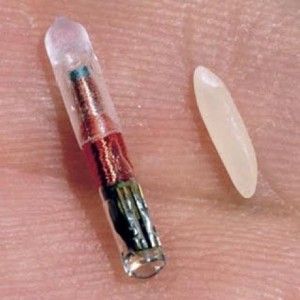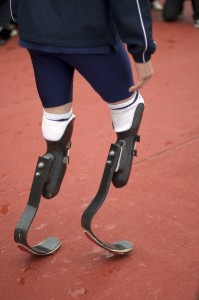Posted in September 2015
Implication of ‘Human Chipping’ on personal identity – Part 1: Are we Cyborgs?
The first RFID implant on a human being was performed in August of 1998 on the upper left arm of Professor Kevin Warwick in Reading, England (Gasson, ICT Implants, 2008). The implant was cylindrical in structure having a length of 22mm and diameter of 4mm. The doctor required to make a small hole, place the RFID chip and close the incision with couple of stitches. The implant allowed Professor Warwick to control lights, open doors and even receive welcome messages when he arrived. His location in the building could be tracked and monitored. This was only experimental and hence other possible applications of the technology were not considered by the scientists at that time.
One of the first commercial application of RFID chips was to replace ‘medic alert’ bracelets by VeriChip Corporation in 2004 (Gasson, ICT Implants, 2008). It was approved by the FDA in the United States of America for human use. It was used to relay medical details when linked to online medical database. For example, the details of the patient’s diabetes can be stored in the chips and because it is implanted, the patient cannot forget it or lose it. Later on the company also used these chips for infant protection and patient monitoring in hospitals. Subsequently these chips were used by nightclubs in Barcelona and Rotterdam to allow access to their VIP members. For example, at the Baja Beach Club in Rotterdam, these chips were implanted in their VIP members and were used for not only entry into the club but also for ordering drinks. For instance, if a member bought a drink, the chip could be read by an RFID reader and the amount can be deducted from the bank directly without the member getting hands on his/her wallet.
In these applications of ‘Human Chipping’, it can be seen that these RFID chips become a permanent part of the person. A person who has an RFID Chip in his arm for some time would become used to its functionality and would not think of it as an electronic component but instead as a part of his body (Gasson, Human implants from invasive to pervasive at TEDxGoodenoughCollege, 2012). How is the RFID implant any different from a person’s leg, hand or any other part of the body? If a person loses their legs in an accident, he will not be able to walk. If prosthetic legs are used he would be able to walk again. These prosthetic legs are made to function as legs such that the person is not able to differentiate it from his legs. They become a part of the person and not as an external component that he has worn. Similarly for the person whose diabetes is being monitored by the RFID implant, the chip becomes a part of the body. If the chip is removed, then the person’s existence would become difficult. His body will not function properly. If we are considering the chip as part of the body, aren’t we cyborgs?
One experiment done by researchers from Vrije University in Amsterdam amplifies the argument that we have become cyborgs. Their experiment involved placing a malicious computer code on a RFID tag, so that if the tag is read by the building system it would get infected by the virus (Rieback, Crispo, & Tanenbaum, 2006). Depending on the virus, it could disrupt the functioning of the building system or spread the virus to the tags used by others. Though this experiment sheds light on the security issues of the technology, we can look at its implications on personal identity. The spread of the computer virus using the implant is analogous to the spread of a communicable disease such as tuberculosis. The virus originates from the RFID tag implanted in a person and passes on to others. It is not possible to separate the RFID tag from the person and say that the virus originated from the tag but not from the person. Think of a situation in which this computer virus corrupts the functioning of every RFID chip that it infects. It might be fatal to a person whose insulin intake is dependent on the RFID chip. This could be a criminal offence but only if the chip is considered as part of the offender, which would make the offender a cyborg.
References:
Gasson, M. (2008). ICT Implants. The Future of Identity in the Information Society, 262, pp. 287-295. Retrieved from BBC: http://www.19.bbc.co.uk
Gasson, M. (2012). Human implants from invasive to pervasive at TEDxGoodenoughCollege. Retrieved from TedX: http://tedxtalks.ted.com/video/Human-implants-from-invasive-to
Rieback, M., Crispo, B., & Tanenbaum, A. (2006). Is your cat infected with a computer virus? IEEE International Conference on Pervasive Computing and Communication, (pp. 169-179).
Technological implants- Therapy or Enhancement?
Technological implants in human beings is not a new phenomenon. The pacemaker is used by many people around the world to help their heart function appropriately. For the past few years, cochlear implants have been performed on people whose hair cells in the inner ear become unresponsive. In this case the implant acts as a replacement for the lost functionality of hair cells. In both these examples, technology is used as a therapy in order to assist in normal functioning of the human being. In the case of cochlear implants, it has been observed that the person with the implant takes few weeks or months to get used to it. It is claimed that though the person is able to hear sounds again, the sounds that they hear is different from what they had experienced before going deaf. In the case of a child which is born deaf, the sounds heard due to the cochlear implant will be the only sounds known. Technology here is a mediator in helping humans achieve their goal of being able to hear sounds. There is no original perception mediated by technology but the mediated perception itself is the original (Ihde, 1990). But what if cochlear implants allowed humans to hear ultrasonic sounds. Humans without cochlear implants cannot hear ultrasonic sounds. In this case, would cochlear implants be a form of therapy or enhancement?
One of the first commercial application of RFID implants was in the field of medicine in order to monitor the patient. This would be considered as a therapy by the hospital. But if we consider the umpteen number of people who do not have access to such technology but have the same diseases, it does seem that patients with implant are privileged and that the implant is an enhancement to their functioning as human beings. Some might say that the privileged ones are ‘better than normal’ (Kurzweil, 2005). They can upload their information or data into the database of the hospital through the internet unconsciously. They don’t need to click a button to send the information. In certain regards, they are uploading a part of themselves which could be looked upon as extending their memory (Clark & Chalmers, 1998). They may not consciously know or remember their current blood sugar level but the medical database of their hospital is updated with the information that can be accessed later if needed.
One possible application of RFID chips would be to implant them on finger tips of a person. Let us consider that a policeman is implanted with an RFID chip containing an infrared sensor, which senses heat, on the index finger of his right hand. If he is entering a house which is dark to catch a crime suspect, he can find in which direction the suspect is by just spatially moving his hand. This gives him additional power compared to his colleagues and is certainly an enhancement to his ‘human qualities’. But Professor Mark Gasson from Reading University has a different view. He does not consider the implants as an enhancement (Gasson, Human implants from invasive to pervasive at TEDxGoodenoughCollege, 2012). Though very few people have RFID implants now, he thinks that soon almost everyone will have it. He compares RFID implants to mobile phones. Earlier very few used mobile phones but in a few years almost everyone in developed and developing nations considers it as a necessity and feels out of place if they do not have a mobile phone. It is possible that in the near future, implants may not remain optional but may become compulsory.
References:
Clark, A., & Chalmers, D. J. (1998). The Extended Mind. The Philosopher’s Annual, XXI, 10-23.
Gasson, M. (2012). Human implants from invasive to pervasive at TEDxGoodenoughCollege. Retrieved from TedX: http://tedxtalks.ted.com/video/Human-implants-from-invasive-to
Ihde, D. (1990). Technology and the lifeworld. Indiana University Press.
Kurzweil, R. (2005). The singularity is near: When humans transcend biology. Viking/Penguin Group




